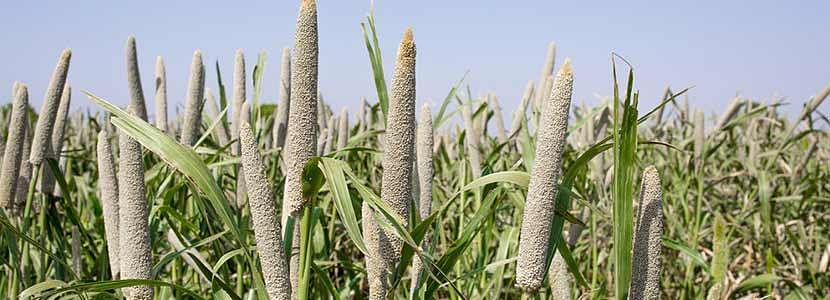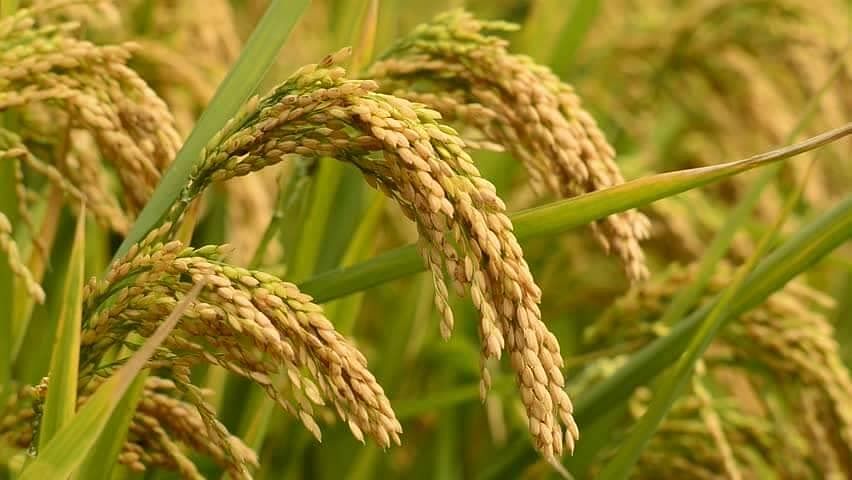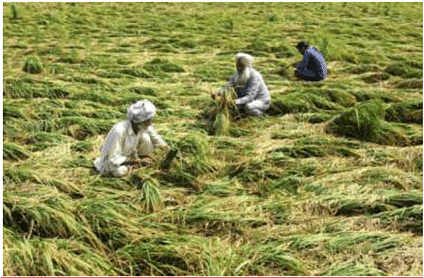Class 9 Economics Chapter 1 Extra Question Answers - The Story of Palampur
Q1. Which crop out of sugarcane, bajra, or wheat are Kharif crops?
Bajra is a rapidly growing warm-weather crop suitable for areas with 40 to 75 cm of annual rainfall.
BajraThus, it is suitable for the Kharif season, which is between July and October. Wheat is not suitable for warm weather and sugarcane requires a full year to grow.
Q2. Identify which out of land, seeds, machinery, and building is in the category of working capital.
Seeds, once used, cannot be used again and so they fall in the category of working capital. Land, machinery, and building are fixed capital, as they can be used again and again.
Q3. What are the constituents of modern farming methods?
The constituents of modern farming methods are the use of a high-yielding variety of seeds, using chemical fertilizers and pesticides, as well as using plenty of water for irrigation.
Q4. Sugarcane crushing undertaken in the village is what type of activity?
Sugarcane crushing undertaken in the village is the first step in the manufacture of jaggery from raw sugarcane. Thus, it is a manufacturing activity.
Q5. What is the main economic activity in village Palampur?
The main economic activity in village Palampur is agriculture.
Agriculture
Q6. What are the factors of production?
Land, labour, physical capital, and human capital are the factors of production.
Q7. What was the major advantage of using HYV seeds in agriculture?
The major advantage of using HYV seeds in agriculture is growing more crops on the same piece of land.
Q8. When large and medium farmers sell their surplus produce in the market, what are the purposes to which they use this income?
A part of the earnings is saved and kept as capital for the next season. Thus, they are able to arrange for the capital for farming from their own savings. Some farmers also use the savings to buy cattle, trucks or use it in other non-agricultural activities.
Q9. What are the non-farming activities being carried out in Palampur?
Some of the non-farming activities being carried out in Palampur include manufacturing, transport, shopkeeping, and computer education.
Q10. Who runs the Primary Health Centre in Palampur?
The Primary Health Centre in Palampur is run by the government.
Q11. What is multiple cropping?
Multiple cropping means that we grow more than one crop on the same piece of land in a year.
Multiple cropping
Q12. Why is loss of soil fertility occurring as an effect of the Green Revolution?
During the Green Revolution, due to the extra crops produced which utilized the soil nutrients fully, no nutrients were left for the next crop.
Q13. What is the disadvantage in using chemical fertilizers in modern farming methods?
The chemicals kill bacteria and microbes, which are essential for soil fertility.
Q14. Which farmers out of landless farmers, small farmers or medium and large farmers, hire labour to work in the fields?
Landless farmers are hired as labourers are hired. Small farmers do not need additional labour, as they work with their family members in the fields. Only the medium and large farmers have extensive work, which makes them hire additional labour.
Q15. What is the standard unit for the measurement of agricultural land?
Hectare is the standard unit for the measurement of agricultural land. Bigha and Guintha are local units used in different parts of India.
Q16. Is it correct that more than half the farmers of Palampur cultivate small plots of land less than 10 hectares in size?
This is incorrect because more than half the farmers of Palampur are small farmers. The plots of these farmers are less than 2 hectares, not less than 10 hectares.
Q17. What is the major reason for people to migrate from rural areas to urban areas?
They migrate in search of better employment opportunities.
Q18. Which crop out of rice, sugarcane or wheat is a Kharif crop?
Rice is a Kharif crop.
Rice crop
Q19. Is it true that foodgrains output in India has increased significantly in the last few years because larger areas of land have been brought under cultivation?
This is not true, because the food grains output has increased due to the use of modern methods of agriculture.
Q20. In 2003, the area cultivated by small farmers in India was how much percentage of the total cultivated area?
The area cultivated by small farmers in India was 36 percent of the total cultivated area.
Q21. Is it true that running a collection cum milk chilling centre in Raiganj is a trading activity?
Yes, since the milk chilling centre is buying the milk from the villagers and selling it to the dairy in the towns/cities. Thus, it is a trading activity.
Q22. Which items out of a tractor, clay, HYV seeds, or a truck will be considered as fixed capital for non-farm activities?
Only a truck is not used in non-farming activity and it is a fixed capital to be used again and again for the transportation of goods.
Q23. Which organizations in India have been developing High Yielding Varieties of seeds?
The development of High Yielding Varieties (HYV) seeds is a research activity, which can only be carried out in research laboratories.
Q24. Can we consider rainfall as a source of irrigation?
No, because irrigation implies the provision of water to crops artificially, whereas rainfall is natural.
Q25. Name the Indian states who were first to try out the modern farming methods in India.
Farmers of Punjab, Haryana, and Western Uttar Pradesh were the first to try out modern farming methods in India.
Q26. What term is used for measuring the crop produced on a given piece of land during a single year?
Yield is measured as a crop produced on a given piece of land during a single season.
Q27. During which season do farmers of Palampur grow jowar and bajra?
During the rainy season (Kharif) farmers of Palampur grow jowar and bajra.
Q28. In which season is wheat grown in Palampur village?
During the rabi season (winter) wheat is grown in Palampur village.
Q29. What are 'Bigha' and 'Guintha'?
Bigha and Guintha are the measuring units of land area in villages.
Q30. What do you understand by the term "Marginal farmers"?
Marginal farmers are those who do not have sufficient land for farming.
Marginal Farmers
Q31. Which is the most labour absorbing sector of the economy?
Agriculture is the most labour absorbing sector of the economy.
Q32. Which state of India has the highest consumption of chemical fertilizer in India?
Punjab has the highest consumption of chemical fertilizer in India.
Q33. What percentage of the total land area is cultivated by medium and large farmers in India?
64 percent total land area is cultivated by medium and large farmers in India.
Q34. Where do most of the small farmers borrow money to arrange for capital in Palampur?
Most of the small farmers borrow money from village moneylenders in Palampur.
Q35. List the changes in Palampur due to the advent of electric power in the village.
The advent of electric power in Palampur has brought about the following changes:
(i) Irrigation is now done through electric run tube wells, which has reduced the dependence of the farmers upon rainfall and enables larger areas of land to be irrigated.
(ii) Irrigation improvement allowed farmers to grow three different crops in a year.
(iii) It enabled Mishrilal to set up a sugarcane crushing machine so that he can sell jaggery manufactured by him to the traders at Shahpur.
Q36. The farm labourers in Palampur usually earn less than the minimum wage. Why?
The use of modem agricultural implements like tractors, thrashers, and harvesters by the large and medium farmers has reduced the amount of agricultural labour required. So, there is competition for work among the agricultural labourers in the village. Knowing that the supply is much more than the demand, the labourers themselves agree to work for wages that are lower than minimum wages. The farmers exploit this condition of excess labour supply and force labourers to work for low wages.
Q37. What is the difference between multiple cropping and modern farming method?
Multiple Cropping: To grow more than one crop on a piece of land during the year is known as multiple cropping. It is the most common way of increasing production on a given piece of land. Modern Farming Method The farmers of Punjab, Haryana and Western Uttar Pradesh use HYV seeds, tube wells for irrigation, chemical fertilizers, and pesticides, as well as machinery like tractors and threshers to increase production. All these measures comprise what is known as modern farming methods.
Q38. Why are farm labourers like Dala and Ramkali poor?
(i) Dala and Ramkali are landless farm labourers who work on daily wages in Palampur.
(ii) The minimum wages for farm labourers set by the government is 115 per day, they get only 80.
(iii) There is heavy competition for work among the farm labourers in Palampur, so people agree to work for lower wages.
(iv) They remain out of work for most parts of the year and have to take loans from the moneylender to fulfill their needs. Due to this seasonal unemployment, they remain poor and are unable to repay the loan, and fall into a debt trap.
Q39. Gosaipur and Majauli are two villages in North Bihar. Out of a total of 850 households in the two villages, there are more than 250 men who are employed in rural Punjab and Haryana or in Delhi, Mumbai, Surat, Hyderabad, or Nagpur. Such migration is common in most villages across India. Why do people migrate? Can you describe based on your imagination the work that the migrants of Gosaipur and Majauli might do at the place of destination?
Most people migrate in search of employment or better job opportunities to the cities like Mumbai, Delhi, etc, or to the prosperous agricultural regions like Punjab and Haryana to work as farm labourers.
(i) This migration usually takes place when a person is unemployed or in extreme poverty, which may be due to lack of land, displacement, negative impact of natural disasters like drought or floods, etc.
(ii) The migrants from Gosaipur and Majauli who went to cities will probably find work as casual labourers, industrial workers, street hawkers, rickshaw pullers, headload workers, or as servants in homes and hotels, etc.
(iii) Those who went to rural areas of Punjab and Haryana will probably work as farm labourers since agriculture is the main occupation of the rural people in these states.
Q40. In what way are Kareem's capital and labour different from Mishrilal?
Both have fixed capital in the form of machines, but Kareem has a larger fixed capital because he has assets in the form of computers which are more expensive than the sugarcane crushing machine. Kareem has also employed educated and qualified computer teachers, whereas Mishrilal's labour is mainly unskilled labour.
Q41. Why didn't someone start a computer centre earlier? Discuss the possible reasons.
Reasons, why someone didn't start a computer centre, may be any of the following:
(i) As very few educated people were there in the village, there was not any demand for computer courses.
(ii) The villagers were not aware of the employment potential of computer courses and so nobody thought that such a business could be successful.
(iii) Teaching faculty for computer courses was not available in the village earlier.
Q42. What is Kishora's fixed capital?
Kishora's fixed capital is the buffalo and wooden cart which he has purchased with the bank loan.
Q43. Modern farming methods require more inputs that are manufactured in industry. Do you agree?
Yes, it is true that modern farming methods require more inputs that are manufactured in industry.
Example: HYV seeds, insecticides, pesticides, and chemical fertilizers needed for increasing the yield per hectare are all manufactured in industries.
Q44. How did the spread of electricity help farmers in Palampur?
(i) Most of the houses in Palampur have electric connections.
(ii) Electricity powers all the tube wells in the fields that help to irrigate much larger areas of land more effectively as compared to the traditional Persian wheel drawn by bullocks. Since the entire cultivated area of 200 hectares had come under irrigation farmers did not have to depend on rainfall and could grow multiple crops.
(iii) It helps small businesses run their machinery like Mishrilal's sugarcane crushing machine.
Q45. Is it important to increase the area under irrigation? Why?
Yes, it is important to increase the area under irrigation because water is very essential for agriculture. In India, the rainfall is unevenly distributed in the country and if rainfall is less, then production will be low, and they will be only able to grow one crop in a season.
Q46. In your region, talk to two labourers Choose either farm labourers or labourers working at construction sites. What wages do they get? Are they paid in cash or kind? Do they get work regularly? Are they in debt?
(i) In our region, there are two labourers namely Ram Khilawan and Basanti, who are husband and wife working as casual constructing labourers. Due to drought, they had to leave their village in search of employment. They get approximately 50 to 60 rupees per day which they are paid in cash.
(ii) They do not get work regularly because there are a large number of workers seeking employment, due to which they agree to work for low wages. Because of irregular work and low wages they are unable to fulfill their needs and are in debt.
Q47. "Dala is a landless farm labourer who works on daily wages in Palampur. The minimum wage for a farm labourer set by the government is 115 per day, but Dala gets only 80. There is heavy competition for work among the farm labourers in Palampur so people agree to work for lower wages." Here Dala is being exploited by the large farmer due to competition among the labourers. What principle is the large farmer violating? How can this malpractice be corrected
In this case, the principle of the minimum wage to be paid to the labourer is being violated by the big farmers. This malpractice can only be controlled by the local authorities who can check the exploitation of landless labourers like Dala in the hands of large farmers.
|
53 videos|437 docs|80 tests
|
FAQs on Class 9 Economics Chapter 1 Extra Question Answers - The Story of Palampur
| 1. What is the story of Palampur? |  |
| 2. What is the importance of the story of Palampur? |  |
| 3. What are the major crops grown in Palampur? |  |
| 4. What are the non-farming activities in Palampur? |  |
| 5. What are the challenges faced by farmers in Palampur? |  |

|
Explore Courses for Class 9 exam
|

|























